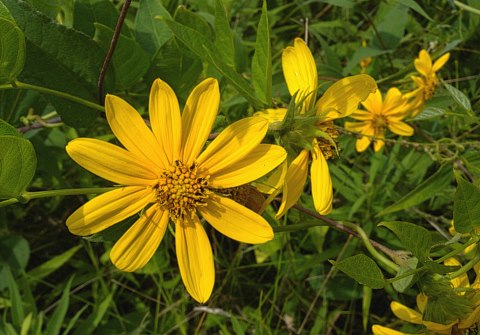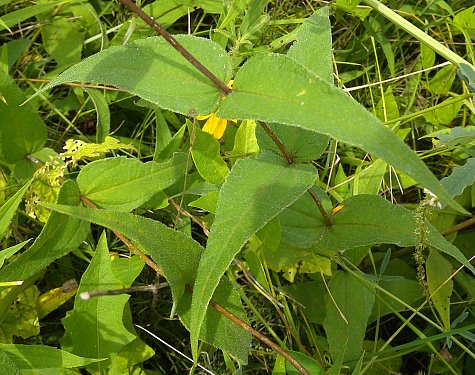
The central and secondary stems terminate in flowerheads on slender peduncles. Individual flowerheads are 1½-3" across, consisting of 8-15 ray florets that surround numerous disk florets. The yellow corollas of the ray florets are petal-like and widely spreading.. The yellow corollas of the disk florets are narrowly tubular (less than 1/8" or 3 mm. long) with 5 spreading lobes. At the base of each flowerhead, there are light green phyllaries (floral bracts) that are arranged in several overlapping series. Individual phyllaries are linear-lanceolate and ciliate along their margins; the outer phyllaries are widely spreading or recurved when the flowerheads bloom. The peduncles of the flowerheads resemble the stems, except they are more likely to have short stiff hairs. The blooming period occurs from mid-summer to early fall for about 2 months. Afterwards, the disk florets are replaced by achenes about 2 mm. long; these achenes are ovoid-oblongoid and somewhat flattened. At the apex of each achene, there is a pair of tiny chaffy scales that easily become detached. The root system is long-rhizomatous. Vegetative colonies of plants are often formed by the rhizomes.
Cultivation: The preference is full or partial sun, moist to dry-mesic conditions, and soil that is loamy, sandy, or rocky. This wildflower is easy to cultivate, although it may spread aggressively.
Faunal Associations: The nectar and pollen of the flowers attract a wide variety of insects. The following bees are specialist pollinators (oligoleges) of Woodland Sunflower and other sunflowers: Andrena accepta, Andrena aliciae, Andrena helianthi, Dufourea marginatus, Melissodes agilis, and Pseudopanurgus rugosus. Other floral visitors include long-tongued bees (honeybees, bumblebees, digger bees, leaf-cutting bees, cuckoo bees, etc.), short-tongued bees (Halictid bees and Andrenid bees), miscellaneous wasps, miscellaneous flies (Syrphid flies, bee flies, thick-headed flies, etc.), butterflies and skippers, and Chauliognathus pennsylvanicus (Goldenrod Soldier Beetle). Other insects feed on the foliage, bore through the stems, suck plant juices, etc., from sunflowers. These species include caterpillars of the butterflies Chlosyne nycteis (Silvery Checkerspot), Chlosyne gorgone (Gorgon Checkerspot), and Vanessa cardui (Painted Lady); the caterpillars of Cochylis hospes (Banded Sunflower Moth), Papaipema necopina (Sunflower Borer Moth), Stiria rugifrons (Sunflower Seed Copper), and other moths. In addition, sunflowers are important host plants for many aphids, treehoppers, leafhoppers, plant bugs, leaf beetles, scarab beetles, the larvae of weevils, the larvae of midges and other small flies, grasshoppers, and other insects (see Insect Table). Some vertebrate animals use sunflowers as a food source. The seeds of these wildflowers are eaten by the Hungarian Partridge, Bobwhite, Mourning Dove, Eastern Goldfinch, Tufted Titmouse, Harris Sparrow, and many other birds. Small mammals that occasionally eat the seeds include the Gray Squirrel and other tree squirrels, Thirteen-Lined Ground Squirrel, Meadow Vole, White-Footed Mouse, and Plains Pocket Gopher. This gopher also feeds on the rhizomes of sunflowers in relatively dry sandy areas. The Cottontail Rabbit browses on the foliage of seedlings and lower leaves of mature plants, while the White-Tailed Deer occasionally chomps off the stems and upper leaves of mature plants. Because the Woodland Sunflower and other sunflowers are relatively tall and often form dense colonies, they provide good ground cover for many kinds of wildlife.

Photographic Location: A moist sand prairie at the Indiana Dunes National Lakeshore in NW Indiana.
Comments: The Woodland Sunflower is easily identified by its sessile, or nearly sessile, opposite leaves. Other sunflowers (Helianthus spp.) have longer petioles. Its stems are usually hairless or mostly hairless, unlike Helianthus hirsutus (Hairy Sunflower) and some other species in this genus. Compared to some narrow-leaved sunflowers that occur in prairies, the leaf bases of Woodland Sunflower are more broad and nearly truncate. Some parasitic plants that occasionally attach their haustoria (root-like extensions) to sunflowers and other species in the Aster family include Cuscuta glomerata (Rope Dodder) and other Cuscuta spp. (generally in moist areas that are often sandy), and Orobanche ludoviciana (Prairie Broomrape) and other Orobanche spp. (generally in dry areas that are often sandy). These parasitic plants can significantly weaken the host plants to which they become attached.